Why Ext JS is the Best Alternative to React JS and Angular JS
With the Internet being commonplace in almost every workplace and household around the globe, web applications have emerged as crucial business tools. This is why building a dynamic and interactive application has become a need of the hour.
When it comes to building such web apps, there is no better option than using an open-source JavaScript framework. But with a plethora of JavaScript frameworks flooding the market, it becomes challenging to select the right one.
Widely regarded as one of the best JavaScript frameworks, Ext JS has become immensely popular among businesses and developers alike. Ext JS not only makes web-application development and maintenance easier but also provides a rich UI for building web apps with cross-browser functionality.
With that said, AngularJS and React JS are also being widely used for building web applications. Even though Ext JS, AngularJS, and React JS have their own advantages, choosing the best one out of the three has become a major problem for developers.
Well, if you are facing such a situation and are not able to decide on the best option, this guide is for you.
Let’s begin the journey with Ext JS.
Ext JS
-1.jpg)
Ext JS, short for Extended JavaScript, is a JavaScript framework from Sencha that is based on the YUI (Yahoo User Interface). It is the most comprehensive JavaScript framework that helps you accelerate web-application development through an enterprise-ready framework, tools, components, and so on. The good thing about Ext JS is that the components and tools are designed to work together seamlessly. Beyond that, Ext JS has several pros that make it stand apart.
Pros of using Ext JS
-
Full-fledged development: Ext JS comes with more than 140 UI components like an HTML5 calendar, a pivot grid, trees, grids, a D3 adapter, lists, forms, menus, windows, toolbars, panels, and many more. The Sencha community offers user extensions in bulk. This means you need not start the development process from scratch, thus saving you both time and extra effort.
-
Advanced designing: Ext JS comes with preintegrated tools, like Sencha Architect, Stencils, and Themer, that allow you to improve the design process.
-
Quality testing: You can improve the quality of your web apps through end-to-end testing using the Sencha test. It is one of the most comprehensive units and end-to-end testing solutions specifically designed for EXT JS.
-
Flexible adaptivity: Ext JS includes a flexible layout manager. You can use it to organize the display of data and content across multiple browsers and devices without worrying about the size of the screen.
You can also control the display of components without worrying about complex user interfaces. Ext JS comes with a responsive config system that allows application components to adapt to specific device orientation or available window size.
-
Solid accessibility: Ext JS has certain features that align with the ADA standards for accessible design. You can easily add accessibility support to your apps through the Ext JS ARIA package. It actually provides tools that are required to achieve section 508 compliance. The ARIA package also allows you to create apps, especially for people who are in dire need of assistive technology like screen readers to navigate the web.
-
Robust data package: Ext JS offers you one of the robust data packages that decouple the UI components from the data layer. You can use this data package to collect client data using highly functional models.
AngularJS
-1.jpg)
AngularJS is a structural framework used for developing complex and dynamic web apps. It gives you the freedom to use HTML as a template language. AngularJS is a full-featured JavaScript framework that allows you to write apps in MVC (Model View Controller) architecture. Moreover, it is basically used to create single-page applications. Apart from this, AngularJS offers many other advantages.
Pros of using AngularJS
-
Data binding: AngularJS has two-way data binding, which means it performs automatic synchronization of data between the model and view components. This will let you treat the model as a single source of truth in your web app.
-
MVC framework: AngularJS is based on the MVC pattern, a software design pattern for web apps. MVC makes it easy to build a separate client-side application.
-
Routing: When it comes to single-page apps, routing is the key aspect. AngularJS prevents users from redirecting to the new page every time they click the menu, so the content will load on the same page even if the URL changes.
-
Dependency injection: The built-in dependency injection subsystem of AngularJS enables you to create, understand, and test the apps without difficulty.
-
User interface with HTML: AngularJS comes with a UI that is built on HTML. HTML is a declarative language that is easy to comprehend And offers a smooth and structured interface.
React JS
-1.jpg)
React JS is an open-source JavaScript library that is specifically used for front-end development. It is a declarative, efficient, and flexible library maintained by Facebook. The good thing about React JS is that it enables you as a developer to reuse the code components of different levels, especially when you are working on various projects. React JS is basically used for responsive single-page applications. And further, it provides you with various other advantages that are listed below.
Pros of using React JS
-
Intuitive: React JS is intuitive to work with. It offers easy interactivity to any UI’s layout. You will get rapid and quality-assured app development.
-
Reusable components: Reusable components can save you both time and effort. The developers have the authority to use them for creating new applications, and this reduces the development effort, thus ensuring flawless performance.
-
Declarative: React JS offers data changes that lead to automatic alteration in the selected parts of the user interfaces, meaning you don’t need to perform any additional steps to update the user interface.
-
Support for components: React JS is a combination of both JavaScript and HTML tags. This makes it easy to deal with a wide set of data containing the document object model.
-
Proficient data-binding: React JS trails one-way data binding, allowing anyone to track the changes made to a particular segment of data.
Comparison
Underlying Architecture
When it comes to architecture, all three frameworks differ from one another. For example, Sencha Ext JS offers various UI components that can be integrated easily with any part of the app. On the other hand, web applications made using AngularJS are based on the hierarchy of components, and it is easy to connect React JS components in any way relevant to the app.
Moreover, whereas React JS apps need external libraries for routing through various pages, AngularJS comes with built-in routing implementations.
Learning Curve
Sencha Ext JS offers a straightforward and component-based experience that allows you to grab things quickly. As such, it doesn’t matter whether you are a beginner or an experienced developer.
React JS is easier to learn because of its intuitive JSX language that brings HTML to JavaScript. Apart from this, it doesn't have any rigid hierarchical structure. On the other hand, AngularJS has a steeper learning curve, which is challenging for new developers. And if you want to migrate from the Angular version to another version, it is not going to be easy.
Security
Ext JS is closed-loop and fully secured. It provides you with a secure set of components to build web-based and mobile platforms the way you want. On the other hand, React JS is also secure enough but cross-site scripting, SQL injection, arbitrary code execution are something that can bother you.
The same is the case with Angular JS where it carries built-in protection against common web apps vulnerabilities and attacks like cross-site scripting, and so on. But it is not secure enough when it comes to application-level security.
Overall performance
AngularJS is known for its speed, but if you add interactive elements in excess, the apps will become slow. React JS is also famous for its excellent loading speed, and you can optimize code for a smoother experience. But if you are looking forward to getting the most out of your apps, Ext JS stands out. You can easily scale it to handle a bigger workload thanks to its enterprise-grade framework.
Flexibility
React JS allows you to import any significant library or framework to the codebase. On the other hand, Angular is more rigid in this area. But things are different with Ext JS as you can easily integrate any major back-end technology without a hassle.
When to go with AngularJS
If you want a smaller footprint and responsive design, choosing AngularJS would be your best bet. It offers cheaper integration of existing third-party integrations. Apart from this, if you are comfortable with CSS and are facing cross-border compatibility issues, AngularJS is a good choice to go with. Moreover, automated testing is something that this JavaScript framework can help you with.
When to go with React JS
If you want to build reusable UI components, React JS is an ideal option. You can rapidly change the data without even reloading the page. Not to mention, it provides you with state containers like Redux that help to develop scalable apps rapidly. And if you have expertise in HTML, CSS, and JavaScript, React JS can help you develop apps the way you want.
When to go with Ext JS
Ext JS is a pure JavaScript framework, which means the entire app is written using plain JavaScript. This gives you an advantage over React JS, where the app is transpiled into JavaScript from JSX.
Furthermore, if you are looking for a faster development process in which you can use ready-made components, there is no match for Ext JS. In addition, its support for MVC and MVVM patterns makes Ext JS unique.
Finally, quick prototyping, solid toolkit support, mobile device and cross-browser support, among others, can aid you a lot in the development process.
Final Takeaway
A lot of JavaScript frameworks available on the market can help you quickly and effortlessly develop apps. Some frameworks perform better in certain areas but lag in others. That’s why, when it comes to selecting the best JavaScript framework, it takes both time and research. The confusion intensifies when you have to choose the best alternative to React JS and AngularJS.
To make this process easier for you, this article provides a full comparison based on the parameters you need to get your job done. There is no doubt that Ext JS is the most comprehensive JavaScript framework and stands out. Ext JS can be used for building data-intensive, cross-platform web and mobile apps. Apart from this, pre-integrated and tested high-performance UI components are capable enough to give both a good pace and ease, especially when you are not an expert. Why not give Ext JS a try to see the results yourself?



